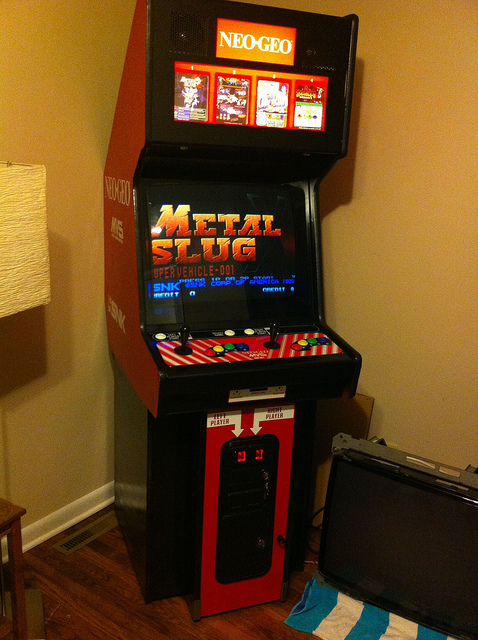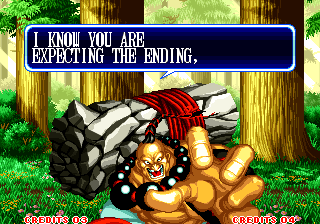Last updated on April 25, 2013
<iframe width=”420″ height=”315″ src=”http://www.youtube.com/embed/t8-pbHpcSqQ” frameborder=”0″ allowfullscreen></iframe>
Please read the text in that introduction, and tell me it isn’t hilarious. Yet, this was one of the best arcade fighting game release of the 1990s. Imagine that! Standards changed, no doubt, from 1994 to the modern day. SNK’s Neo Geo tells us a lot about this.
I don’t know the first time I became familiar with the company known as SNK. Back in the early 1990s, it’s not as if who made what product concerned me all that much – all I cared about was that they were fun and worth my time (that standard being relative to a person below the age of ten, obviously). I first remember playing my SNES, but the arcades always loomed as a sort of promised land. Living in New England, arcades weren’t readily available without quite a drive, and that just wasn’t a reality for a person in my age group, nor really a desire.
However, I do remember an acquaintance with the games of SNK through their SNES ports, specifically games like Fatal Fury and Art of Fighting. After playing a great deal of Street Fighter II and getting bored, I figured I’d rent a similar product (falling right into SNK’s trap, apparently). These were different games that played quite differently, and I loved the bright colors, the character designs, and the animated quality of the graphics. I’ve always had a hankering for 2D pixel art, and perhaps it came from this era in my life. People thought I was crazy when I bought Street Fighter Alpha 3 instead of Ehrgeiz – let me say I got the better of that deal!
Of course, how could I even know that SNK produced arcade games or that these were ports? Information came few and far between through magazines; at best, maybe I’d see a preview of yet another port for yet another SNK game. Where were they all coming from, I wonder? What is this mysterious “arcade” everyone discusses in hushed tones and whispers? It’s like my SNES or Genesis seemed third-rate compared to…something out there, something I hadn’t seen before. So what was it, then? Well, I imagine I’d been to an arcade before, but it’s not as if you six or seven year-old brain makes the connection when you’ve got so much other stuff to play with (notably, Teenage Mutant Ninja Turtles and Legos, but this is a video game blog so I’m sticking with that).
When I went to Walt Disney World one year, though, I finally saw one of those SNK “Big Red” arcade cabinets. I was staying at the Gateway Motal at the time, and what else would be in the lobby in the 1990s but a bunch of arcade cabinets? Ah, those were the days. But it made quite an impression! By God, is that thing HUGE:
It’s amazing that someone can fit this in their house without somebody looking at them funny. I literally needed a stool or some other propping device just to play it. Notably, most SNK cabs contain multiple slots as per the MVS board contained within, so I had my choice of games. Of all things, apparently, I picked Samurai Shodown II, which was and still is an excellent demonstration of SNK’s prowess in the 2D realm. Gloriously Engrished beyond repair but sporting all those little animated details and touches, it truly looked great and still plays great even today. I still remember Wan Fu’s gigantic and scary mug from back then:
Ah, good times. We accepted bad English translations because, really, it didn’t much matter when the focus of the game came down to “beat other person up”, or in SamSho’s case “slice other person in half”. SNK’s popularity in the United States reached its height around 1994-95, and eventually went downhill with the advent of 3D games, but I still remembered playing SamSho II. Unfortunately, having a taste of the promised land (so to speak) meant that I could imagine, if not play, all the subsequent releases on SNK’s arcade system. EGM2 did a cover for Real Bout: Fatal Fury, for example, and I obsessively pored over the contents of movelists and systems for game I’d never play. Or so I thought…
With the advent of “The Internet” as we know it, I wanted to buy a gaming PC to play Unreal Gold. I picked up an issue of Computer Gaming World (brilliant magazine, RIP) which burst at the seams with previews for hundreds of new games, including Grim Fandango (which I never ended up buying, for shame!) and Half-Life (which would go on to usurp Unreal’s crown as people discovered its genius), but I wanted Unreal, of all things. So I bought it, and I played it, and it was all well and good. However, the Internet brought about the true discovery, so I looked up the Neo Geo – lo and behold, fansites exist! Neo-Geo.com became a frequent destination – look at all the stuff SNK released! How can I play this? The prices looked exorbitant for AES consoles and ShockBoxes and all these weird hobbyists accouterments, but I really didn’t care.
AND WHAT SAMURAI SHODOWN SEQUELS? Man, I hit the motherload! Then I saw the Last Blade too, and I was sold.
It should surprise no one that I discovered emulators around that same time, so I HAD to play Samurai Shodown IV at any cost. Using my incredibly bad dial-up connection, I downloaded the full 20MB game (which took all of one whole night) and played it. Even with a crappy keyboard, I played gleefully. It was no coincidence that, at the same time, I’d received one of those Microsoft Sidewinder controllers bundled with Motocross Madness (a rather good game in that genre, but let’s not get off topic), so I actually had a controller to play it with; NeoRageX became a treasure trove of unreleased (at least in my mind) hits, and who could resist? Emulators took work back then, boys and girls, and lots of time to download this stuff. So yes, it was highly illegal, but it’s hard for a kid to actually know this in the Wild West of the Internet.
A lot of this also explains the piles of arcade joysticks in my house, the dozens of fighting games ports (not cabs or actual hardware – what am I, crazy?), and the immense fun I’ve had since the advent of online play. I don’t think it’s purely nostalgic – these games stand the test of time with their sense of craft and mechanical depth even today. I stuck to 2D games even after they faded from the public light, and now they’ve returned. Who would have thought that would happen?
However, the lack of understanding towards this past concerns me greatly. Video games evolved, yes, but they’re not neccessarily “better”. When people emphasize the “meaning” of the game rather than the mechanics, or the fun, or any of the elements that make it lighthearted entertainment, they’ve thrown off the supposed “shackles” of the past. This is a mistake, and I am finding that my perspective of games does not fit the modern paradigm – if it doesn’t live on, then it just won’t exist and my favorite pasttime becomes a vehicle for self-expression rather than a good time. That’s what I want to avoid – video games were unique for their ability to provide people with interactive entertainment, but the compartmentalizing and focus on internal struggles that modern games insert looks towards an increasingly narcisstic culture. We make the player important, so important that a power fantasy becomes a choice fantasy.
Where did all the fun go, you might ask? Well, justifying your favorite hobby as an art form probably did much to create that perception, but there’s always that impulse to cast whatever ME, MYSELF, and I are doing as some important work. Newsflash: not always! Sometimes, we need to remember the past to make our future that much better, and that’s why companies like EA, Square-Enix, Capcom, and others find themselves in a rut – they’re doing what everyone else does (i.e., create unbeleviably unrealistic expectations to appeal to the Call of Duty audience) rather than what made them unique in the past. It’s a shame, really, and our mindset perpetuates this: games need to grow up, and “fun” isn’t a requirement (“games” in the phrase non-withstanding). I assert otherwise, as my The List entries make pretty clear – why can’t we have both, and why shouldn’t we DEMAND both? Some mediums just aren’t fit for certain topics without stripping one elements or another, and that’s rather shameful that we must swallow the reduction of the mechanical elements for the sake of “meaning”
The entire book of Hebrews describes how the Gospel narrative fits into the realm of the Old Testament, and we can see that remembering the past helps us in our future. We learn what NOT to do, for one, but also see what they did right. Many people obeyed (Abraham, David), and disobeyed (same list, psych!), but we can learn from both aspects. Sin litters the text of the OT, from the most lightweight to the heaviest and most perverse, but all remain a powerful tool and reminder that the past remains incredibly relevant to our present – sin hasn’t changed a whole lot, and hasn’t become less attractive. Don’t throw the baby out with the bathwater, in other olde timey metaphors. I use Hebrews 3 in this case:
12 Take care, brethren, that there not be in any one of you an evil, unbelieving heart that falls away from the living God. 13 But encourage one another day after day, as long as it is still called “Today,” so that none of you will be hardened by the deceitfulness of sin. 14 For we have become partakers of Christ, if we hold fast the beginning of ourassurance firm until the end, 15 while it is said,
“Today if you hear His voice,
Do not harden your hearts, as when they provoked Me.”16 For who provoked Him when they had heard? Indeed, did not all those who came out of Egypt led by Moses? 17 And with whom was He angry for forty years? Was it not with those who sinned, whose bodies fell in the wilderness? 18 And to whom did He swear that they would not enter His rest, but to those who were disobedient? 19 So we see that they were not able to enter because of unbelief.
If the Old Testament weren’t important, there’s no reason for Hebrews to exist; the past would not help us. Yet, from our perspective, all the Bible is “in the past” to some extent. We can’t pick and choose the important elements; we have to figure out which parts remain essential – which, for me, would be the whole of it. Perhaps this Biblicist perspective informs my video game habits, in that I don’t like making sacrifices in mechanical depth for a narrative, nor do I like slapping my hobby with nonsense words which make “like” into “art”. I’m not into that gig, and neither should you.
Why settle for less


